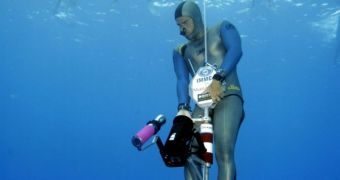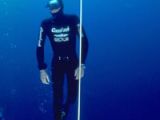In the first 9 months of our lives, we live like aquatic beings in the womb of the mother. But that's all. After that, the water environment is forbidden for us: we can swim at the surface, but less under water.
One famous and remarkable example (but not the only one) are the famous Japanese ama woman divers. Ama are famous for pearl diving, but in fact they dive for food like seaweed, shellfish, lobsters, octopus, sea urchins and oysters, which sometimes produce pearls. Most of ama are women because they naturally have more body fat, which ensures a better isolation in colder water. Ama can dive till depths of 30 m (100 ft) without any scuba equipment!
Still, there are champions that in apnea can dive to 150 m (500 m)! This requires indeed special physical and mental abilities, due to the water's behavior. Some champions have the lung capacity of 8 liters (the average is 4-6 l). And many take classes of yoga[admark=1] to train their respiration and mind.
Water is 800 times denser than the air. That's why diving below a certain depth requires compensating the external pressure with the internal one using increasingly light gases. When the oxygen is breathed at over 1.8 atmospheres (equivalent of below 8 m (26 ft) underwater), it becomes toxic. That's why, for security reasons, it must not be used under 7 m (23 ft).
The nitrogen is toxic under 35 m (116 ft) and can produce narcosis. This happens because under the great water pressure the nitrogen dissolves in the blood, and when the pressure decreases, nitrogen bubbles form in the blood, blocking blood circulation in the brain. This can be deadly, if blood vessels break.
There are three types of poisoning with gas: with carbon monoxide, carbon dioxide and oxygen, even at small doses below depths of 90 m (300 ft).
Decompression is the process through which the external pressure (of the water) and inner (of the body) are equalized, through a controlled ascent. It is not necessary in case of shallow immersions. The speed of the ascent must be of 10 m (33 ft)/minute. If decompression is not made, the diver risks to die of nitrogen narcosis and blood/lung embolism (when small amounts of air block the blood vessels).
At 150 m of depth (this means 15 atmospheres), the heart beat drops to 9 beats/minute and the body's extremities lose circulation. Diving to these depths is made along a right cable marking the depth.
The descend with constant weight is the most simple and hard at the same time. The diver must reach the maximum depth using just his/her legs, which are also used for the ascent, without touching the cable that measures the depth. The record is of 81 m (270 ft).
In the case of the descend with variable weight, the diver has a maximum of 30 kg (67 pounds) burden to reach the maximum depth. The burden is abandoned at the bottom and the diver ascends by himself/herself. The use of any help, like air balloons, is forbidden. The record is of 115 m (383 ft).
The descend with absolute variable weight means reaching the maximum depth with the help of a burden without weight limit. The ascend is made with the help of an air balloon, but the last 40 m (133 ft) must be made without the balloon, in order to avoid the risk of ascending too quickly. The record is of 152 m (507 ft).

 14 DAY TRIAL //
14 DAY TRIAL // 

